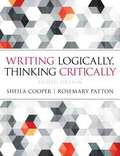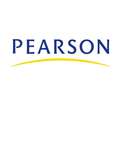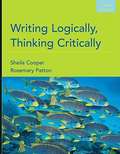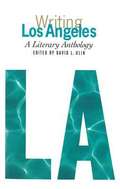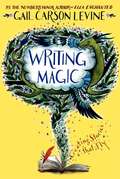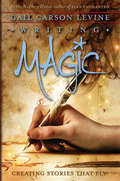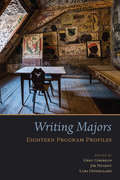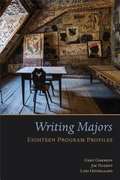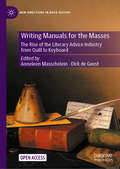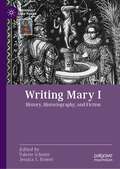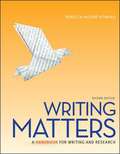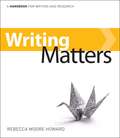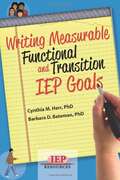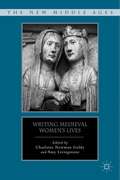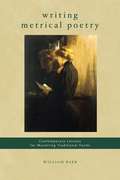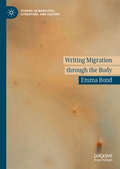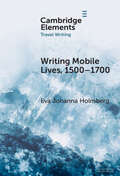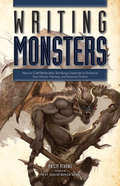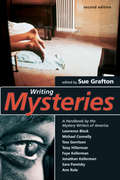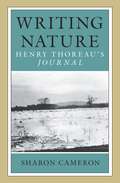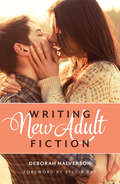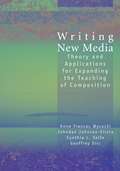- Table View
- List View
Writing Logically, Thinking Critically
by Sheila Cooper Rosemary PattonThis concise, accessible text teaches students how to write logical, cohesive arguments and how to evaluate the arguments of others. Integrating writing skills with critical thinking skills, this practical book teaches students to draw logical inferences, identify premises and conclusions and use language precisely. Students also learn how to identify fallacies and to distinguish between inductive and deductive reasoning. Ideal for any composition class that emphasizes argument, this text includes coverage of writing style and rhetoric, logic, literature, research and documentation.
Writing Logically, Thinking Critically
by Sheila Cooper Rosemary PattonThis concise, accessible text teaches students how to write logical, cohesive arguments and how to evaluate the arguments of others. Integrating writing skills with critical thinking skills, this practical book teaches students to draw logical inferences, identify premises and conclusions and use language precisely. Students also learn how to identify fallacies and to distinguish between inductive and deductive reasoning. Ideal for any composition class that emphasizes argument, this text includes coverage of writing style and rhetoric, logic, literature, research and documentation.
Writing Logically, Thinking Critically (6th Edition)
by Sheila Cooper Rosemary PattonThis concise, accessible text teaches students how to write logical, cohesive arguments and how to evaluate the arguments of others. Integrating writing skills with critical thinking skills, this practical book teaches students to draw logical inferences, identify premises and conclusions and use language precisely. Students also learn how to identify fallacies and to distinguish between inductive and deductive reasoning. Ideal for any composition class that emphasizes argument, this text includes coverage of writing style and rhetoric, logic, literature, research and documentation.
Writing Los Angeles: A Literary Anthology (A Library Of America Special Publication)
by David L. UlinIn this book, The Library of America presents a glittering panorama of the city, encompassing fiction, poetry, essays, journalism, and diaries by over seventy writers. This revelatory anthology brings to life the entrancing surfaces and unsettling contradictions of the City of Angels, from Raymond Chandler’s evocation of the murderous moods fed by the Santa Ana winds to John Gregory Dunne’s affectionate tribute to “the deceptive perspectives of the pale subtropical light.” Here are fascinating strata of Los Angeles’s cultural and social history, from the oil boom of the 1920s to the graffiti artists of the 1980s, from flamboyant evangelist Aimee Semple MacPherson to surf music genius Brian Wilson, from the German émigré intellectuals chronicled by Salka Viertel to the hard-bitten homicide cops tracked by James Ellroy. Here are its fragile ecosystems, its architectural splendors, and its social chasms, in the words of writers as various as M.F.K. Fisher, William Faulkner, Bertolt Brecht, Evelyn Waugh, Octavio Paz, Joan Didion, Walter Mosley, and Mona Simpson. Art Pepper discovers Central Avenue in the heyday of the 1940s jazz scene; Charles Mingus describes an early encounter with the builder of the Watts Towers; screenwriter Robert Towne reflects on the origins of Chinatown; John McPhee powerfully conveys the devastation of Los Angeles mudslides; David Hockney teaches himself how to drive in record time; and Pico Iyer finds at Los Angeles International Airport “as clear an image as exists today of the world we are about to enter.” This book is an incomparable literary tour guide to a city of shifting identities and endless surprises.
Writing Magic: Creating Stories That Fly
by Gail Carson LevineNewbery Honor author Gail Carson Levine shares her discoveries for writing exciting stories.
Writing Magic
by Gail Carson LevineDo you want to write stories that catch your readers and never let go? Have you ever wondered how to create a book as magical as Ella Enchanted, as touching as Dave at Night, as captivating as Fairest? Well, now you can find out! In Writing Magic, Newbery Honor author Gail Carson Levine shares her secrets of great writing. She shows how you, too, can get terrific ideas for stories, invent great beginnings and endings, write sparkling dialogue, develop memorable characters-;and much, much more. She advises you about what to do when you feel stuck-;and how to use helpful criticism. Best of all, she offers writing exercises that will set your imagination on fire. With humor, honesty, and wisdom, Gail Carson Levine shows you that you, too, can make magic with your writing.
Writing Majors: Eighteen Program Profiles
by Greg Giberson Jim Nugent Lori OstergaardThe writing major is among the most exciting scenes in the evolving American university. Writing Majors is a collection of firsthand descriptions of the origins, growth, and transformations of eighteen different programs. The chapters provide useful administrative insight, benchmark information, and even inspiration for new curricular configurations from a range of institutions. A practical sourcebook for those who are building, revising, or administering their own writing majors , this volume also serves as a historical archive of a particular instance of growth and transformation in American higher education. Revealing bureaucratic, practical, and institutional matters as well as academic ideals and ideologies, each profile includes sections providing a detailed program review and rationale, an implementation narrative, and reflection and prospection about the program. Documenting eighteen stories of writing major programs in various stages of formation, preservation, and reform and exposing the contingencies of their local and material constitution, Writing Majors speaks as much to the “how to” of building writing major programs as to the larger “what,” “why,” and “how” of institutional growth and change.
Writing Majors
by Lori Ostergaard Greg Giberson Jim NugentThe writing major is among the most exciting scenes in the evolving American university. Writing Majors is a collection of firsthand descriptions of the origins, growth, and transformations of eighteen different programs. The chapters provide useful administrative insight, benchmark information, and even inspiration for new curricular configurations from a range of institutions.A practical sourcebook for those who are building, revising, or administering their own writing majors, this volume also serves as a historical archive of a particular instance of growth and transformation in American higher education. Revealing bureaucratic, practical, and institutional matters as well as academic ideals and ideologies, each profile includes sections providing a detailed program review and rationale, an implementation narrative, and reflection and prospection about the program.Documenting eighteen stories of writing major programs in various stages of formation, preservation, and reform and exposing the contingencies of their local and material constitution, Writing Majors speaks as much to the "how to" of building writing major programs as to the larger "what," "why," and "how" of institutional growth and change.
Writing Manuals for the Masses: The Rise of the Literary Advice Industry from Quill to Keyboard (New Directions in Book History)
by Anneleen Masschelein Dirk De GeestThis open access collection of essays examines the literary advice industry since its emergence in Anglo-American literary culture in the mid-nineteenth century within the context of the professionalization of the literary field and the continued debate on creative writing as art and craft. Often dismissed as commercial and stereotypical by authors and specialists alike, literary advice has nonetheless remained a flourishing business, embodying the unquestioned values of a literary system, but also functioning as a sign of a literary system in transition. Exploring the rise of new online amateur writing cultures in the twenty-first century, this collection of essays considers how literary advice proliferates globally, leading to new forms and genres.
Writing Mary I: History, Historiography, and Fiction (Queenship and Power)
by Valerie Schutte Jessica S. HowerThis book—along with its companion volume Mary I in Writing: Letters, Literature, and Representations—centers on representations of Queen Mary I in writing, broadly construed, and the process of writing that queen into literature and other textual sources. It spans an equally wide chronological and geographical scope, accounting for the years prior to her accession in July 1553 through the centuries that followed her death in November 1558 and for her reach across England, and into Ireland, Spain, Italy, Russia, and Africa. Its intent is to foreground words and language—written, spoken, and acted out—and, by extension, to draw out matters of and conversations about rhetoric, imagery, methodology, source base, genre, narrative, form, and more. Taken together, these volumes find in England’s first crowned queen regnant an incomparable opportunity to ask new questions and seek new answers that deepen our understanding of queenship, the early modern era, and modern popular culture.
Writing Matters: A Handbook for Writing and Research
by Rebecca Moore HowardWriting Matters unites research, reasoning, documentation, grammar and style in a cohesive whole, helping students see the conventions of writing as a network of responsibilities writers have.
Writing Measurable Functional and Transition IEP Goals
by Cynthia M. Herr Barbara D. BatemanWriting Measurable Functional and Transition IEP Goals is a new book by the leading IEP author team! Students with severe and multiple disabilities typically do not get sufficient, direct, individual instruction in functional and transition skills areas. These include social skills, communication, transportation training, leisure-recreation, self-care, housekeeping, and many others. This lack of functional skill training can also be a problem for those with moderate or mild disabilities. This book addresses all these groups with its focus squarely on two instructional steps: writing measurable goals (target behaviors,) and identifying steps on the way to those goals (task analysis). It is patterned after the coauthors' highly successful and definitive book, Writing Measurable IEP Goals and Objectives, but emphasizes functional goals for transition students.
Writing Medieval Women’s Lives
by Charlotte Newman Goldy Amy LivingstoneA collection of essays representing the growing variety of approaches used to write the history of medieval women. They reflect the European medieval world socially, geographically and across religious boundaries, engaging directly with how the medieval women's experience wa reconstructed, as well as what the experience was.
Writing Metamorphosis in the English Renaissance
by Susan WisemanTaking Ovid's Metamorphoses as its starting point, this book analyses fantastic creatures including werewolves, bear-children and dragons in English literature from the Reformation to the late seventeenth century. Susan Wiseman tracks the idea of transformation through classical, literary, sacred, physiological, folkloric and ethnographic texts. Under modern disciplinary protocols these areas of writing are kept apart, but this study shows that in the Renaissance they were woven together by shared resources, frames of knowledge and readers. Drawing on a rich collection of critical and historical studies and key philosophical texts including Descartes' Meditations, Wiseman outlines the importance of metamorphosis as a significant literary mode. Her examples range from canonical literature, including Shakespeare's A Midsummer Night's Dream and The Tempest, to Thomas Browne on dragons, together with popular material, arguing that the seventeenth century is marked by concentration on the potential of the human, and the world, to change or be changed.
Writing Metrical Poetry: Contemporary Lessons For Mastering Traditional Forms
by William BaerWrite poetry in the great metrical tradition of Dante, Shakespeare, Dickinson, Frost, and the poets of the current Formalist revival. In this contemporary guide, you'll learn how to write metrical poetry in all the major forms, from blank verse and quatrains to sonnets and villanelles. Each chapter provides step-by-step instruction that's accessible and easy to understand for even the beginning poet.
Writing Migration through the Body (Studies in Mobilities, Literature, and Culture)
by Emma BondWriting Migration through the Body builds a study of the body as a mutable site for negotiating and articulating the transnational experience of mobility. At its core stands a selection of recent migration stories in Italian, which are brought into dialogue with related material from cultural studies and the visual arts. Occupying no single disciplinary space, and drawing upon an elaborate theoretical framework ranging from phenomenology to anthropology, human geography and memory studies, this volume explores the ways in which the skin itself operates as a border, and brings to the surface the processes by which a sense of place and self are described and communicated through the migrant body. Through investigating key concepts and practices of transnational embodied experience, the book develops the interpretative principle that the individual bodies which move in contemporary migration flows are the primary agents through which the transcultural passages of images, emotions, ideas, memories – and also histories and possible futures – are enacted.
Writing Mobile Lives, 1500–1700 (Elements in Travel Writing)
by null Eva Johanna HolmbergThis Element develops and showcases a new methodological framework in which to study the connections between early modern travel writing and life- and self-writing. Turning the scholarly focus in the study of travel writing from eye-witnessing and proto-ethnography of foreign lands to the 'fashioned' and portrayed selves and 'inner worlds' of travellers – personal memory, autobiographical practices, and lived yet often heavily mediated travel experiences – it opens up perspectives to travel writing in its many modes, that extend both before and after 'lived' travels into their many pre- and afterlives in textual form. This title is also available as Open Access on Cambridge Core.
Writing Monsters: How to Craft Believably Terrifying Creatures to Enhance Your Horror, Fantasy, an d Science Fiction
by Philip AthansMonsters are more than things that go bump in the night... Monsters are lurking in the woods, beneath the waves, and within our favorite books, films, and games--and there are good reasons why they appear so often. Monsters are manifestations of our fears and symbols of our society--not to mention they're a lot of fun--but each should serve a purpose and enhance the themes and tension in your fiction. In Writing Monsters, best-selling author Philip Athans uses classic examples from books, films, and the world around us to explore what makes monsters memorable--and terrifying. You'll learn what monsters can (and should) represent in your story and how to create monsters from the ground up. Writing Monsters includes: In-depth discussions of where monsters come from, what they symbolize, and how to best portray them in fiction Informative overviews of famous monsters, archetypes, and legendary creatures A Monster Creation Form to help you create your monster from scratch An annotated version of H.P. Lovecraft's chilling story "The Unnamable" Whether you write fantasy, science fiction, or horror, your vampires, ghouls, aliens, and trolls need to be both compelling and meaningful. With Writing Monsters, you can craft creatures that will wreak havoc in your stories and haunt your readers' imaginations--and nightmares.
Writing Motherhood
by Lisa GarriguesHave you always wanted to chronicle your experience of motherhood, but never knew how to begin? Are you looking for an outlet for self-expression, but can't imagine how you could juggle one more thing? In Writing Motherhood, longtime writing teacher Lisa Garrigues dispels the myth that motherhood is an impediment to creativity. Drawing on her own efforts to balance the demands of motherhood with her dream of writing, she shows readers how everyday life can be a rich source of stories, and how writing can provide a means to both understand and document their experiences. Whether you are a new mother or a grandmother, someone who has long aspired to write or someone who has never written before, Writing Motherhood will help you find your voice and tap into your creative self. Filled with insight, honesty, and humor, each chapter of Writing Motherhood weaves together stories from the author's life with wisdom from other writers and mothers. In daily writing Invitations, Lisa then encourages readers to tell their own stories. Along the way, she reveals how to: Start and fill a Mother's Notebook -- in just fifteen minutes a day. Silence the critical voices that stifle creativity. Throw away the rules that bind the imagination. Carve out the time and space for writing. Find a community of other mothers who want to write. Beautifully written and thought-provoking, this inviting and inspiring book will strike a chord with any mother looking to explore and reflect on her experience of motherhood. Here she will discover that mothering provides endless material for writing at the same time that writing brings clarity and wisdom to mothering. Writing Motherhood is an essential guide for mothers at every age and stage of life.
Writing Mysteries: A Handbook by the Mystery Writers of America (2nd edition)
by Sue GraftonHere's your ticket to the greatest mystery-writing workshop ever!In this extraordinary compilation, more than three dozen members of the Mystery Writers of America share insights and advice that can help make your writing dreams a reality.You'll learn how to:Develop unique ideasConstruct an airtight plot packed with intrigue and suspenseCreate compelling characters and atmospheric settingsDevelop a writing style all your ownWrite convincing dialogueChoose the appropriate point of viewWork with an agentConduct accurate researchand much, much more! You'll also find special guidelines for creating clues, dropping red herrings, and writing medical, legal, historical, true crime, and young adult mysteries. It's all the information you need to solve the mystery-writing riddle!
Writing Mysteries for Young People
by Joan Lowery NixonJoan Lowery covers each aspect of writing mysteries, in easy-to-follow steps and provides many examples for each. All the information a writer needs to know is there. Learn what a "plant" is. Make a chart to show where all characters are at any given moment in the course of the mystery so alert readers are satisfied there is no cheating.
Writing Nature: Henry Thoreau's Journal
by Sharon CameronAt his death, Henry Thoreau left the majority of his writing unpublished. The bulk of this material is a journal that he kept for twenty-four years. Sharon Cameron's major claim is that this private work (the Journal) was Thoreau's primary work, taking precedence over the books that he published in his lifetime. Her controversial thesis views Thoreau's Journal as a composition that confounds the distinction between public and private--the basis on which our conventional treatment of discourse depends.
Writing New Adult Fiction: How to Write and Sell New-Adult Fiction
by Deborah HalversonJoin the New Adult Fiction revolution! From Sylvia Day's Bared to You to Jamie McGuire's Beautiful Disaster, new adult fiction has arrived--and it's hotter than ever. But there's more to this category than its 18-to-26-year-old characters: The success of your story depends on authentically depicting the transition of your young protagonists from teenhood to adulthood. With Writing New Adult Fiction, you'll learn how to capture the spirit of freedom, self-discovery, and romance that defines the new adult experience. Create memorable characters that act and sound like new adults. Sculpt a distinct personality for your fiction with POV, voice, tone, and word choices. Build a unique, captivating plot that satisfies your audience from beginning to end. Learn tools for revising effectively and efficiently in a speed-driven market. Weigh the options for your path to publication: traditional, indie, and hybrid. The new adult category is filled with opportunities to break in with distinct plots and original characters. Make your mark by writing a novel that's fresh, unique--and wholly new adult!
Writing New Media: Theory and Applications for Expanding the Teaching of Composition
by Anne WysockiAs new media mature, the changes they bring to writing in college are many and suggest implications not only for the tools of writing, but also for the contexts, personae, and conventions of writing. An especially visible change has been the increase of visual elements-from typographic flexibility to the easy use and manipulation of color and images. Another would be in the scenes of writing-web sites, presentation "slides," email, online conferencing and coursework, even help files, all reflect non-traditional venues that new media have brought to writing. By one logic, we must reconsider traditional views even of what counts as writing; a database, for example, could be a new form of written work. The authors of Writing New Media bring these ideas and the changes they imply for writing instruction to the audience of rhetoric/composition scholars. Their aim is to expand the college writing teacher's understanding of new media and to help teachers prepare students to write effectively with new media beyond the classroom. Each chapter in the volume includes a lengthy discussion of rhetorical and technological background, and then follows with classroom-tested assignments from the authors' own teaching.
